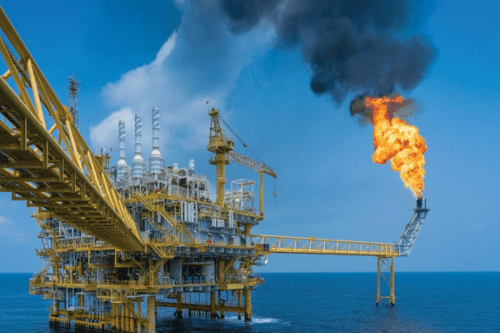Hóa dầu, hay dầu khí, là nguyên liệu chính trong cuộc sống hàng ngày của chúng ta. Cùng TDP IELTS học qua các từ vựng tiếng Anh chuyên ngành dầu khí mà chúng mình đã tổng hợp nhé! Bài viết này sẽ cung cấp hơn 160+ từ vựng tiếng Anh dành cho kỹ sư dầu khí.

Nội dung
ToggleTừ vựng tiếng Anh chuyên ngành dầu khí – Các loại xăng dầu
Học thêm các từ vựng tiếng Anh về chuyên ngành dầu khí sẽ cung cấp cho bạn 1 lượng kiến thức lớn về dầu khí. Bỏ túi ngay từ vựng tiếng Anh chuyên ngành dầu khí sau:
Asphalt Base Crude Oil (Dầu Thô Nền Asphan):
- Phân loại: Dầu thô
- Mô tả: Dầu thô có cơ sở là asphan, được sử dụng trong các quá trình sản xuất và chế biến dầu.
Aviation Gasoline (Avgas) (Xăng Máy Bay):
- Phân loại: Xăng
- Mô tả: Loại xăng được sử dụng trong động cơ máy bay.
Black Oil (Dầu Đen):
- Phân loại: Dầu
- Mô tả: Dầu có màu đen, có thể là kết quả của quá trình chưng cất và xử lý.
Bleached Oil (Dầu Mất Màu):
- Phân loại: Dầu
- Mô tả: Dầu đã trải qua quá trình làm mất màu để loại bỏ màu sắc không mong muốn.

Brent Crude (Dầu Brent):
- Phân loại: Dầu thô
- Mô tả: Dầu thô được khai thác từ một số mỏ dầu ở vùng Biển Bắc, thường có chất lượng tốt.
Coal Oil (Dầu Than Đá):
- Phân loại: Dầu
- Mô tả: Dầu có thể được chiết xuất từ than đá và được sử dụng cho các mục đích năng lượng.
Condensate (Dầu Ngưng, Khí Ngưng):
- Phân loại: Dầu thô
- Mô tả: Dầu thô nhẹ được hình thành từ quá trình ngưng tụ của hơi nước và các hợp chất khác trong quá trình sản xuất khí.
Crude Oil (Dầu Thô):
- Phân loại: Dầu thô
- Mô tả: Dầu thô là dạng chưa được chế biến của dầu mỏ, được chiết xuất từ mỏ dầu.
Diesel Fuel (Nhiên Liệu Diesel):
- Phân loại: Dầu
- Mô tả: Loại nhiên liệu sử dụng trong động cơ diesel.
Diesel Oil (Dầu Điezen):
- Phân loại: Dầu
- Mô tả: Dầu được sử dụng trong động cơ diesel.
EBP (Ethanol Blended Petrol) (Xăng Không Chì):
- Phân loại: Xăng
- Mô tả: Xăng được pha trộn với ethanol, thường được sử dụng để giảm khả năng gây ô nhiễm.
FOD (Fuel Oil Domestique) (Dầu Đốt Nóng):
- Phân loại: Dầu
- Mô tả: Dầu được sử dụng trong hệ thống sưởi và nấu ăn.
Fuel Oil (FO) (Dầu Mazut, Dầu Nhiên Liệu):
- Phân loại: Dầu
- Mô tả: Dầu được sử dụng làm nhiên liệu cho các loại động cơ khác nhau, bao gồm cả nồng độ lưu huỳnh cao.
Gasoline (Xăng):
- Phân loại: Xăng
- Mô tả: Xăng là một loại nhiên liệu dạng lỏng được sử dụng trong động cơ đốt trong.
Gasoil:
- Phân loại: Dầu
- Mô tả: Sản phẩm chưng cất trung gian được sử dụng cho nhiên liệu diesel.
Gasohol:
- Phân loại: Xăng
- Mô tả: Xăng được pha trộn với cồn ở nồng độ từ 5,7% đến 10% thể tích.
Green Oil (Dầu Xanh):
- Phân loại: Dầu
- Mô tả: Dầu có màu xanh, có thể do các chất phụ gia màu xanh được thêm vào.
Heavy Crude Oil (Dầu Nặng):
- Phân loại: Dầu thô
- Mô tả: Dầu thô có độ nhớt cao, khó di chuyển và chế biến.
HSFO (High Sulfur Fuel Oil) (Dầu Nhiên Liệu Chứa Lưu Huỳnh Cao):
- Phân loại: Dầu
- Mô tả: Dầu nhiên liệu chứa lượng lưu huỳnh cao, thường được sử dụng trong các ngành công nghiệp.

Từ vựng tiếng Anh chuyên ngành dầu khí – Khai thác dầu khí

Từ vựng tiếng Anh chuyên ngành dầu khí về khai thác dầu khí là cần thiết. điểm qua ngay các từ vựng tiếng Anh chuyên ngành dầu khí dưới:
- Adsorption Gasoline (Xăng Hấp Thụ):
- Example: Adsorption gasoline is produced through a process where certain components are selectively retained for improved fuel quality.
- Adverse Mobility Ratio (Suất Linh Động Ngược, Tỷ Số Linh Động Ngược):
- Example: An adverse mobility ratio in an oil reservoir can lead to inefficient oil recovery, making extraction more challenging.
- Aniline Point (Điểm Anilin):
- Example: Determining the aniline point of a petroleum product is crucial for understanding its solubility and potential uses.
- Antisludge Agent (Tác Nhân Chống Cặn):
- Example: Antisludge agents are added to lubricating oils to prevent the formation of sludge and maintain engine performance.
- Basic Sediment and Water (Nước Và Tạp Chất Cơ Sở):
- Example: The separation of basic sediment and water is a critical step in refining crude oil to ensure the purity of the final products.
- Blending Plant (Thiết Bị Pha Trộn):
- Example: A blending plant combines various components to create customized fuel blends with specific properties.
- Blendstock (Thành Phần Kết Hợp Với Các Chất Khác để Tạo Thành Một Sản Phẩm Lọc Dầu):
- Example: Ethanol is often used as a blendstock in the production of gasoline to enhance octane levels.
- Bloom (Sự Huỳnh Quang Của Dầu):
- Example: The bloom observed in certain oils under specific conditions is a result of fluorescence and can indicate the oil’s quality.
- Bonded Petroleum Imports (Kho Xăng Dầu Nhập Khẩu):
- Example: Bonded petroleum imports are stored in customs-controlled warehouses until duties are paid.
- Bulk Station (Trạm Nạp Liệu):
- Example: A bulk station serves as a distribution point for large quantities of petroleum products, facilitating efficient transportation.
- Catalyst (Chất Xúc Tác):
- Example: A catalyst is used in refining processes to speed up chemical reactions without being consumed in the process.
- Correlation Index (Chỉ Số Liên Kết):
- Example: The correlation index helps analysts understand the relationship between different variables in petroleum studies.
- Enhanced Oil Recovery (Tăng Cường Thu Hồi Dầu):
- Example: Steam injection is a common technique used in enhanced oil recovery to reduce viscosity and improve oil flow in reservoirs.
- Farm-Out (Cho Nhượng Lại Sau Khi Thuê):
- Example: After conducting exploration, an oil company may decide to farm-out certain drilling rights to another company for development.
- Field (Khu Mỏ Dầu):
- Example: The Prudhoe Bay field in Alaska is one of the largest oil fields in North America, contributing significantly to oil production.
- Fractional Distillation (Chưng Cất Phân Đoạn):
- Example: Fractional distillation is employed in refineries to separate crude oil into different fractions based on boiling points.
- Kyoto Protocol (Nghị Định Thư Kyoto):
- Example: The Kyoto Protocol aims to reduce greenhouse gas emissions globally, including those from the oil and gas industry.
- Petrochemical Feedstocks (Nguyên Liệu Hóa Dầu):
- Example: Ethylene and propylene are essential petrochemical feedstocks used to produce various chemical products.
- Petroleum Engineer (Kỹ Sư Khai Thác Dầu Khí):
- Example: A petroleum engineer designs and implements methods to extract oil and gas from underground reservoirs.
Xem thêm:
– Từ vựng tiếng Anh chuyên ngành cơ khí
– Từ vựng tiếng Anh chuyên ngành Y
– Từ vựng tiếng Anh chuyên ngành bếp
Từ vựng tiếng Anh chuyên ngành dầu khí – Chuyên ngành hóa dầu
Đừng quên bỏ túi những thuật ngữ và từ vựng tiếng Anh chuyên ngành dầu khí chuyên ngành dầu khí – hóa dầu cực bổ ích cho bạn dưới đây nha!
Absorption (Hấp Thụ):
- Example: Absorption towers are used in refineries to remove impurities by absorbing them into a solvent.
Additive (Chất Phụ Gia):
- Example: Fuel additives are substances added to enhance the performance or properties of the fuel.
Appreciable (Đáng Kể):
- Example: The increase in oil prices had an appreciable impact on the economy of oil-producing countries.
Alteration (Sự Biến Đổi):
- Example: The alteration of crude oil properties during refining processes determines the quality of the final products.
Ambient (Môi Trường Xung Quanh):
- Example: Ambient temperature and pressure conditions are considered when assessing the behavior of petroleum products.
Barrel (159 Liters):
- Example: The standard oil barrel, equivalent to 159 liters, is widely used as a unit of measurement in the oil and gas industry.
Asphalt (Nhựa Đường):
- Example: Asphalt, derived from crude oil, is used in road construction and various industrial applications.
Assay (Sự Phân Tích, Thí Nghiệm):
- Example: The assay of crude oil involves analyzing its composition to determine its suitability for specific refining processes.
Boiling Point (Điểm Sôi):
- Example: The boiling point of a liquid is the temperature at which it changes from a liquid to a vapor.
Blend (Hỗn Hợp):
- Example: Gasoline is a blend of different hydrocarbons with varying boiling points.

Characteristics (Đặc Tính):
- Example: The characteristics of different crude oil types impact their refining and processing requirements.
By-products (Sản Phẩm Phụ):
- Example: Refining crude oil results in various by-products such as petroleum coke and asphalt.
Chemistry (Hóa Học):
- Example: The study of the chemistry of crude oil helps understand its composition and behavior during refining.
Charcoal (Than, Chì Than):
- Example: Charcoal, produced by heating wood in the absence of oxygen, is used in various industrial applications.
Comparable (Có Thể So Sánh Được):
- Example: The properties of different crude oil streams are analyzed to determine if they are comparable for processing in the same unit.
Comprehensive (Toàn Diện):
- Example: A comprehensive analysis of a refinery’s operations considers various factors, including safety, efficiency, and environmental impact.
Coke (Cốc):
- Example: Petroleum coke is a solid carbon material derived from oil refining processes.
Consistency (Tính Cứng Rắn):
- Example: The consistency of lubricating oils is crucial for their performance in machinery.
Conversion (Sự Chuyển Hóa):
- Example: Conversion processes in a refinery transform heavy fractions into lighter and more valuable products.
Condensation (Sự Ngưng Tụ):
- Example: Condensation occurs when vapor turns into a liquid, such as dew forming on a surface.
Decomposition (Sự Phân Huỷ):
- Example: Decomposition of organic compounds in crude oil can result in the formation of undesirable by-products.
Crude (Dầu Thô):
- Example: Crude oil is extracted from reservoirs and serves as the primary raw material for the production of various petroleum products.
Desalt (Khử Muối):
- Example: Desalting is a refining process that removes salt and other impurities from crude oil.
Diameter (Đường Kính):
- Example: The diameter of a pipeline is a critical factor influencing the flow rate of oil and gas.
Distillation (Chưng Cất):
- Example: Distillation is a widely used refining process to separate different components of crude oil based on their boiling points.
Drain (Rút, Tháo):
- Example: It is necessary to drain water and sediment from storage tanks to prevent contamination of refined products.
Drill (Khoan):
- Example: Drilling is an essential process in the exploration and extraction of crude oil and natural gas.
Electrode (Điện Cực):
- Example: Electrodes are used in various processes, including electrolysis, to facilitate chemical reactions.
Extraction (Sự Chiết Tách):
- Example: Solvent extraction is a common method for separating specific components from crude oil.
Xem thêm:
– Từ vựng tiếng Anh chuyên ngành bóng đá
– Từ vựng tiếng Anh chuyên ngành bán lẻ
– Từ vựng tiếng Anh chuyên ngành công an
–Từ vựng tiếng Anh chuyên ngành công nghệ thực phẩm
– Từ vựng tiếng Anh chuyên ngành bảo hiểm
Thuật ngữ tiếng Anh chuyên ngành dầu khí
Các từ vựng tiếng Anh chuyên ngành dầu khí chuyên sâu sẽ hữu ích cho bạn khi tìm hiểu về dầu khí. Học ngay từ vựng tiếng Anh chuyên ngành dầu khí sau:
- Adsorption Gasoline (Xăng Hấp Thụ):
- Example: Adsorption gasoline is produced by selectively removing impurities through adsorption processes.
- Alcohol (Cồn):
- Example: Ethanol is a common type of alcohol used as a fuel additive to enhance octane levels in gasoline.
- Alkylate (Sản Phẩm Ankyl Hoá):
- Example: Alkylate is a high-octane blending component produced in the alkylation process for gasoline.
- Alkylation (Alkyl Hóa):
- Example: Alkylation is a chemical process that involves combining olefins and isobutane to produce high-octane alkylate.
- Alteration (Sự Biến Đổi):
- Example: The alteration of crude oil properties during refining is essential to meet specific product requirements.
- Ambient (Môi Trường Xung Quanh):
- Example: Ambient temperature refers to the temperature of the surrounding environment without any artificial heating or cooling.
- API (American Petroleum Institute) (Viện Dầu Khí Mỹ):
- Example: The API gravity scale is used by the American Petroleum Institute to measure the density of petroleum liquids.
- ASTM (American Society for Testing Materials) (Hội Kiểm Nghiệm Vật Liệu Mỹ):
- Example: ASTM standards are widely used in the petroleum industry to ensure the quality and consistency of materials.
- Atmospheric Crude Oil Distillation (Phương Pháp Chưng Cất Dầu Thô Trong Khí Quyển):
- Example: Atmospheric crude oil distillation separates crude oil into various fractions based on boiling points at atmospheric pressure.
- Archie’s Equation (Phương Trình Archie):
- Example: Archie’s equation is commonly used in petrophysics to estimate water saturation in subsurface formations.
- Aromatics (Hương Liệu, Chất Thơm):
- Example: Aromatics, such as benzene and toluene, are important components in the production of petrochemicals.
- Asphalt Plant (Thiết Bị Tái Sinh):
- Example: An asphalt plant is equipped for the production of asphalt used in road construction.
- Aviation Gasoline Blending Components (Thành Phần Pha Trộn Xăng Máy Bay):
- Example: A variety of chemicals are used as aviation gasoline blending components to meet specific aviation fuel requirements.
- Asphalt (Nhựa Đường Atphan):
- Example: Asphalt, derived from crude oil, is widely used in the construction of roads and pavements.
- Baler (Ống Hút Dầu):
- Example: A baler is a device used to collect and contain oil spills on the water surface.
- Catalyst Cracker (Thiết Bị Cracking Xúc Tác):
- Example: The catalyst cracker is a key unit in the refinery that facilitates the cracking process to produce valuable products.
- Catalytic Hydrotreating (Tách Các Hợp Chất của Dầu Bằng Hydro Xúc Tác):
- Example: Catalytic hydrotreating is employed to remove impurities from crude oil, improving its quality.
- Catalytic Reforming (Phương Pháp Reforming Xúc Tác):
- Example: Catalytic reforming is a refining process that enhances the octane rating of gasoline.
- Cetane Number (Chỉ Số Xetan):
- Example: The cetane number of diesel fuel is an important factor influencing its combustion characteristics.
- Charcoal (Than, Chì Than):
- Example: Charcoal, derived from the carbonization of wood, is used in various industrial applications.
- Comparable (Có Thể So Sánh Được):
- Example: The properties of different crude oil streams are analyzed to determine if they are comparable for processing in the same unit.
- Condensation (Sự Ngưng Tụ):
- Example: Condensation is the process by which a vapor turns into a liquid, often forming droplets.
- Consistency (Tính Cứng Rắn):
- Example: The consistency of asphalt is crucial in road construction to ensure durability and performance.
- Cloud Point (Điểm Mù):
- Example: The cloud point of a diesel fuel indicates the temperature at which wax crystals begin to form.
- Correlation Index (Chỉ Số Liên Kết):
- Example: The correlation index is used to establish a relationship between two or more variables in the petroleum industry.
- Crude Oil Stream (Dòng Dầu Thô):
- Example: The crude oil stream from different wells varies in composition and requires specific refining processes.
- Charge Capacity (Công Suất Tích Nạp):
- Example: The charge capacity of a refinery refers to its ability to process a certain volume of crude oil per day.
- CIF (Cost, Insurance, and Freight) (Chi Phí, Bảo Hiểm, Vận Tải):
- Example: CIF is a commonly used trade term indicating that the cost of goods includes insurance and freight charges to the specified destination.
- Comprehensive (Toàn Diện):
- Example: A comprehensive analysis of crude oil qualities includes assessing its chemical composition, density, and sulfur content.
- Conversion (Sự Chuyển Hóa):
- Example: Conversion processes in a refinery transform heavy and less valuable fractions into lighter, more valuable products.
- Crude Oil Qualities (Chất Lượng Dầu Thô):
- Example: Understanding crude oil qualities is essential for selecting the appropriate refining processes to obtain desired products.
- Crude Oil Losses (Sự Tổn Thất Về Dầu Thô):
- Example: Measures are taken to minimize crude oil losses during transportation and refining processes.
- Crude Oil Production (Sản Xuất Dầu Thô):
- Example: The increase in crude oil production has led to changes in global energy markets and supply dynamics.
- Crude Oil Stream (Dòng Dầu Thô):
- Example: The crude oil stream from a particular reservoir may have unique properties, requiring customized refining strategies.
- Decomposition (Sự Phân Huỷ):
- Example: The decomposition of organic compounds in crude oil occurs at elevated temperatures during refining.
- Deasphalting (Khử Atphan):
- Example: Deasphalting is a process used to remove asphaltic compounds from crude oil.
- Delayed Coking (Luyện Than Cốc):
- Example: Delayed coking is a thermal cracking process used to convert heavy residues into valuable products.
- Desalt (Khử Muối):
- Example: Desalting is a crucial step in the refining process to remove salt content from crude oil.
- Desulfurization (Khử Lưu Huỳnh):
- Example: Desulfurization units are employed to reduce sulfur content in refined products, complying with environmental standards.
- Diameter (Đường Kính):
- Example: The diameter of pipelines used in the oil and gas industry is a critical factor influencing flow rates.
- Downstream (Hạ Nguồn):
- Example: Downstream operations in the petroleum industry involve refining, distribution, and marketing of refined products.
- Drain (Rút, Tháo):
- Example: It is essential to drain excess water and impurities from storage tanks to maintain product quality.
- Drill (Khoan):
- Example: Drilling is a primary method used in the exploration and extraction of crude oil and natural gas.
- Distillation (Chưng Cất):
- Example: Distillation is a widely used refining process to separate different components of crude oil based on their boiling points.
- Electrode (Điện Cực):
- Example: Electrodes are used in electrolysis processes to facilitate chemical reactions in refining.
- Evaporation (Sự Bay Hơi):
- Example: Evaporation is a natural process by which volatile components in a liquid turn into vapor.
Lời kết
Trên đây là các từ vựng tiếng Anh chuyên ngành dầu khí mà TDP IELTS tổng hợp. Hy vọng với các từ vựng tiếng Anh chuyên ngành dầu khí trên, bạn sẽ có thêm hiểu biết về chuyên ngành này. Ghé thăm FB TDP IELTS để học thêm nhiều từ vựng nhé.








![[CHÍNH THỨC] Đáp Án Đề Thi THPTQG Môn Tiếng Anh 2024 đầy đủ nhất](https://tdp-ielts.edu.vn/wp-content/uploads/2024/06/dap-an-de-thi-thptqg-mon-tieng-anh-2024-tdp-ielts.png)


